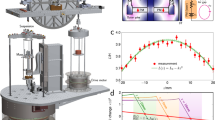Abstract
The explanation of inertia based on “Mach's principle” is briefly revisited and an experiment whereby the gravitational origin of inertia can be tested is described. The test consists of detecting a small stationary force with a sensitive force sensor. The force is presumably induced when a periodic transient Mach effect mass fluctuation is driven in high voltage, high energy density capacitors that are subjected to 50 kHz, 1.3 kV amplitude voltage signal, and threaded by an alternating magnetic flux of the same frequency. An effect of the sort predicted is shown to be present in the device tested. It has the expected magnitude and depends on the relative phase of the Mach effect mass fluctuation and the alternating magnetic flux as expected. The observed effect also displays scaling behaviors that are unique to Mach effects. Other tests for spurious signals suggest that the observed effect is real.
Similar content being viewed by others
REFERENCES
C. Hoefer, “Einstein's formulations of Mach's principle,” in Mach's Principle:From Newton's Bucket to Quantum Gravity J. Barbour, and H. Pfister, eds. (Birkh¨auser, Boston, 1995), pp. 67-90.
D. Sciama, “On the origin of inertia,” Mon. Not. Roy. Astron. Soc. 113, 34-42 (1953).
H. Bondi and J. Samuel, “The Lens-Thirring effect and Mach's principle,” Phys. Lett. A 228, 121-126 (1997).
D. W. Sciama, “The physical structure of general relativity,” Rev. Mod. Phys. 36, 463-469 (1964).
D. J. Raine, “Mach's principle in general relativity,” Mon. Not. Roy. Astron. Soc. 171, 507-528 (1975).
B. Haisch, A. Rueda, and H. Puthoff, “Inertia as a zero-point-eld Lorentz force,” Phys. Rev. A 49, 678-694 (1994).
J. F. Woodward and T. Mahood, “What is the Cause of Inertia?” Found. Phys. 29, 899-930 (1999).
J. F. Woodward, “Gravity, inertia, and quantum vacuum zero point elds,” Found. Phys. 31, 819-835 (2001).
J. F. Woodward, “Making the universe safe for historians:Time travel and the laws of physics,” Found. Phys. Lett. 8, 1-39 (1995).
J. F. Woodward, “Twists of fate:Can we make traversable wormholes in spacetime?” Found. Phys. Lett. 10, 153-181 (1997).
J. F. Woodward, “Measurements of a Machian transient mass fluctuation,” Found. Phys. Lett. 4, 407-423 (1991).
J. F. Woodward, “A stationary apparent weight shift from a transient machian mass fluctuation,” Found. Phys. Lett. 5, 425-442 (1992).
J. F. Woodward, “A laboratory test of Mach's principle and strong-eld relativistic gravity,” Found. Phys. Lett. 9, 247-293 (1996).
J. F. Corum, J. P. Dering, P. Pesavento, and A. Donne, “EM stress-tensor space drive,” in Space Technology Applications International Forum, Proceedings, M. S. El-Genk, ed., American Institute of Physics, Woodbury, NY, 1999, AIP CP-458, pp. 1027-1032.
H. H. Brito and S. A. Elaskar, “Direct experimental evidence of electromagnetic inertia manipulation thrusting,” in AIAA/ASME/SAE/ASEE Joint Propulsion Conference and Exhibit, Proceedings, AIAA Paper No. 2003-4989, 2003.
J. F. Woodward, “Breakthrough propulsion and the foundations of physics,” Found. Phys. Lett. 16, 25-40 (2003).
J. F. Woodward, "The technical end of Mach's principle,” in Mach's Principle and the Origin of Inertia, M. Sachs and A. R. Roy, eds. (Apeiron, Montreal, 2003), pp. 19-36.
C. H. Brans, “Mach's principle and the locally measured gravitational constant in general relativity,” Phys. Rev. 125, 388-396 (1962).
Author information
Authors and Affiliations
Rights and permissions
About this article
Cite this article
Woodward, J.F. Flux Capacitors and the Origin of Inertia. Foundations of Physics 34, 1475–1514 (2004). https://doi.org/10.1023/B:FOOP.0000044102.03268.46
Issue Date:
DOI: https://doi.org/10.1023/B:FOOP.0000044102.03268.46




